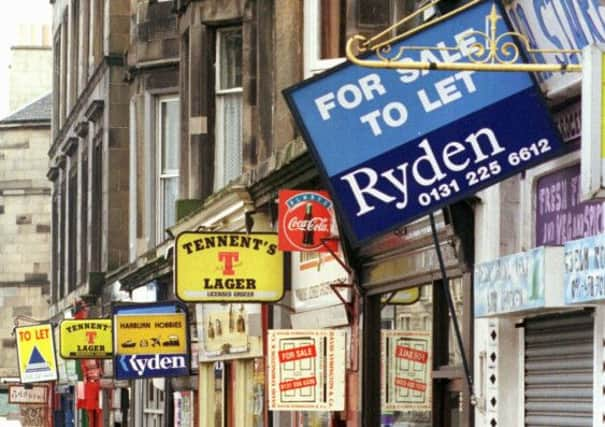4 in 10 empty shops in Scotland vacant for years


Experts warned that empty high street stores, particularly in smaller towns, create a “major barrier to healthy and sustainable places”.
The comprehensive report into the health of the high street in 100 of Scotland’s towns and cities, published by the Local Data Company and the Institute for Retail Studies and launched today, found that Scotland has a higher retail vacancy rate than the rest of the UK at 13.7 per cent of all shops.
Advertisement
Hide AdAdvertisement
Hide AdUK-wide, the vacancy rate is 13.3 per cent. However, the gap has narrowed markedly since 2013, when vacancy rates were 14.5 per cent north of the Border.
The number of empty shops in Scotland has soared since the recession in 2008, when the retail sector was hard hit by many major chains sliding into administration.
The Scottish Government earlier this year announced its “Town Centres First” policy, which urges public bodies to retain their facilities in the middle of local towns, in a bid to revive flagging centres. A separate government-commissioned review, published last year and led by architect Malcolm Fraser, said that a strong mix of leisure, public facilities and homes are needed in town centres to create a thriving community.
CONNECT WITH THE SCOTSMAN
• Subscribe to our daily newsletter (requires registration) and get the latest news, sport and business headlines delivered to your inbox every morning
Matthew Hopkinson, director of the Local Data Company, said: “The report identifies important trends as well as quashing common perceptions that deprived towns can’t succeed.
“Of particular significance is that, in many Scottish towns, almost 40 per cent of the vacant units have been vacant for more than three years. Such a stark figure implies obsolescence and a major barrier to healthy and sustainable communities.”
East Kilbride has the highest vacancy rate of all Scottish towns at 33 per cent – but Dundee has the highest proportion of persistent vacancy at 11 per cent.
The Aberdeenshire market town of Inverurie, which has a thriving economy due to the high proportion of oil industry workers based there, continues to have the lowest vacancy rate at just 1 per cent. Ellon – also in Aberdeenshire – alongside North Berwick, Dunbar and Biggar, have also seen low vacancy rates, having maintained vacancy rates at less than 6 per cent for the past three years.
Advertisement
Hide AdAdvertisement
Hide AdDavid Lonsdale, director of the Scottish Retail Consortium, said: “More needs to be done to make it easier and less costly for retailers to invest in new premises. Top priorities should be an overhaul of the business rates system, and a more flexible and less time-consuming approach to approving building warrants, in order to get shops trading promptly.”
More than half of retail units in Scotland’s towns are occupied by independent shops. Anstruther in Fife boasts the highest proportion of independent stores at 86 per cent with Gretna, lowest at just 5 per cent.
Professor Leigh Sparks, head of the Institute for Retail Studies at Stirling University, said: “Understanding the changing retail component of towns remains fundamental to our comprehension of the functioning of Scotland’s urban centres. The data provide an opportunity for further analysis and the development of policy initiatives to support the government’s ambitions for Scotland’s towns.”
SCOTSMAN TABLET AND IPHONE APPS